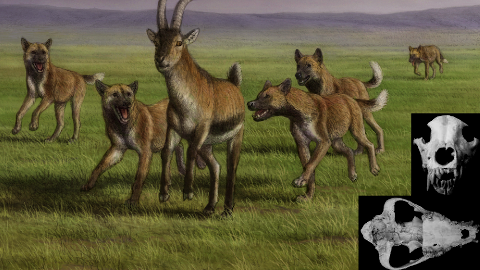Prehistoric hunting dogs may have lived alongside early humans in Europe
Remains of a prehistoric hunting dog recently discovered in Dmanisi, Georgia may be the earliest evidence that hunting dogs moved to Europe. The findings, which suggest that hunting dogs may have lived alongside early humans found in the same location, are published in Scientific Reports.

An international research team coordinated by the professor of the University of Florence Saverio Bartolini-Lucenti, with the participation of the researcher Joan Madurell, from the UAB Department of Geology and from the Institut Català de Paleontologia Miquel Crusafont (ICP) analysed the remains of a large dog, dated to between 1.77 and 1.76 million years ago. The specimen is the earliest known case of a hunting dog near Europe, preceding the widespread movement of hunting dogs from Asia to Europe and Africa during the Calabrian stage (1.8 to 0.8 million years ago) of the Pleistocene Epoch.
The authors identified distinct dental structures that suggest the Dmanisi dog belonged to the species Canis (Xenocyon) lycaonoides, the Eurasian hunting dog, which originated in East Asia and may be the ancestor of African hunting dogs alive today. The dog’s dental features also match other wild dog-like species (Canids) from the same era and today that have been identified as highly carnivorous (over 70% meat in their diet). These features include narrower and shorter third premolars than those of omnivores and an enlarged and sharp carnassial (tooth in the middle of the jaw that shreds food). The authors did not find significant wear on the teeth, suggesting the dog was a young but large adult, estimating its weight at around 30kg.
As human remains found previously in Dmanisi are the earliest direct evidence of early humans moving out of Africa approximately 1.8 million years ago, the current findings suggest that hunting dogs and early humans lived alongside each other in Dmanisi. The Eurasian hunting dogs may have then moved dispersed across Africa, Asia and Europe in line with other studies, becoming one of the most widespread carnivores of the fossil record.
Reference paper:
Bartolini-Lucenti, S., Madurell-Malapeira, J., Martínez-Navarro, B. et al. The early hunting dog from Dmanisi with comments on the social behaviour in Canidae and hominins. Sci Rep 11, 13501 (2021). https://doi.org/10.1038/s41598-021-92818-4